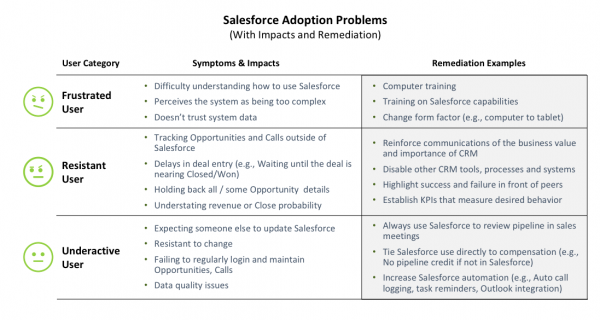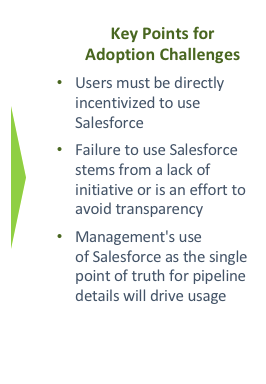
How to Solidify Salesforce User Adoption

Getting the Most Value from your Salesforce Platform
Deploying Salesforce requires a significant investment of time and capital. Smart companies develop a business case and tie an ROI to future revenue increases or productivity gains to justify their Salesforce investment. Without effective (“well adopted”) use of Salesforce postulated in the business case, however, the ROI falls short of expectations and the business leaders have some explaining to do.
Evolution of Salesforce
In the early days of Salesforce, adoption was measured using basic metrics like number of logins or login frequency. Business leaders quickly learned that tracking logins didn’t necessarily indicate effective use of the platform. A Sales Executive might say, “Everyone logged in every day this month. Why aren’t we seeing a lift in revenue? Why aren’t we closing deals faster, we’re using Salesforce!” More sophisticated adoption strategies are needed to define and measure the seller behaviors that make a real difference to the top line or productivity metrics.

Drive Salesforce Adoption
Here are the top 4 things you must do to drive Salesforce adoption:

- Set meaningful KPIs. Research and establish a small set of rich KPIs that measure the desired seller behaviors to achieve your objectives. Build an adoption scoring algorithm that captures the adoption effectiveness in one metric.
- Force usage. Adopt the mindset, “If it’s not in Salesforce, it doesn’t exist”. Run your sales meetings using a Salesforce Pipeline Report. Decommission your old CRM platform – if you were using one – as soon possible, forcing your sales team to manage Opportunities in Salesforce.
- Nurture change champions. Got an email from a colleague asking for an Opportunity update? Bring the email content into Salesforce, respond in Chatter and @mention your colleague.
- Use peer pressure to your advantage. Using your adoption metrics, build a Wall of Fame and Wall of Shame dashboard to stack-rank you sales team members. Let their competitive nature drive the behaviors you’re after.
In my next article, I’ll outline an adoption scoring algorithm and demonstrate how to measure the performance of your sales team using metrics that really matter to your Salesforce ROI.
Want to learn more? Click here to consult with an expert today.




